Ellagic acid
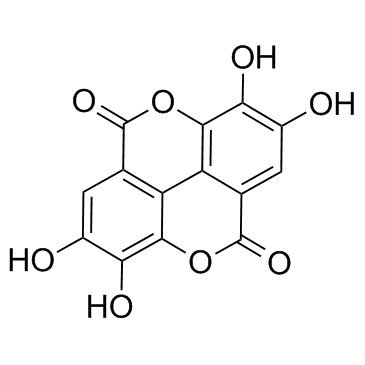
Ellagic acid structure
|
Common Name | Ellagic acid | ||
|---|---|---|---|---|
| CAS Number | 476-66-4 | Molecular Weight | 302.193 | |
| Density | 2.1±0.1 g/cm3 | Boiling Point | 796.5±60.0 °C at 760 mmHg | |
| Molecular Formula | C14H6O8 | Melting Point | ≥350 °C | |
| MSDS | Chinese USA | Flash Point | 310.1±26.4 °C | |
| Symbol |

GHS07 |
Signal Word | Warning | |
Use of Ellagic acidEllagic acid is a natural antioxidant, and acts as a potent and ATP-competitive CK2 inhibitor, with an IC50 of 40 nM and a Ki of 20 nM. |
| Name | ellagic acid |
|---|---|
| Synonym | More Synonyms |
| Description | Ellagic acid is a natural antioxidant, and acts as a potent and ATP-competitive CK2 inhibitor, with an IC50 of 40 nM and a Ki of 20 nM. |
|---|---|
| Related Catalog | |
| Target |
CK2:40 nM (IC50) |
| In Vitro | Ellagic acid is a potent CK2 inhibitor, with an IC50 of 40 nM and a Ki of 20 nM. Ellagic acid also blocks other kinases such as LYN, PKA, SYK, GSK3, FGR and CK1, with IC50s of 2.9, 3.5, 4.3, 7.5, 9.4 and 13.0 μM, respectively, and shows no obvious effects on DYRK1a, CSK, NPM-ALK, RET and FLT3 (IC50s > 40 μM). Ellagic acid (5-100 μM) shows inhibitory activities against Karpas299, SUDHL1, SR786, and FE-PD cell lines[1]. Ellagic acid (10 μM) exhibits cytotoxic effects on MCF-7 cells after treatment of radiation. Ellagic acid (10 μM) in combination with Irradiation (IR) significantly abridges the capacity of MCF-7 cells to form colonies equated with individual treatments. Ellagic acid with IR also induces cell apoptosis, and facilitates the upregulation of pro-apopttotic Bax and downregulation of Bcl-2 in MCF-7 cells[3]. |
| In Vivo | Ellagic acid (EA; 10 mg/kg/day; p.o., 14 days) strongly decreases MDA brain content by 17%, and reduces the levels of brain TNF-α by 42% in rats. Ellagic acid markedly increases the reduced brain contents of 5-HT (39%), dopamine (DA, 71%), and norepinephrine (NE, 77%). Ellagic acid (10 mg/kg, p.o., 14 days) causes decreased histopathological changes induced by Doxorubicin in rats[2]. |
| Kinase Assay | CK2 and CK1 phosphorylation assays are carried out at 37°C in the presence of increasing amounts of each inhibitor (Ellagic acid) in a final volume of 25 µL containing 50 mM, Tris-HCl pH 7.5, 100 mM NaCl, 12 mM MgCl2, 0.02 mM [33P-ATP] (500-1000 cpm/pmol), unless otherwise indicated. The phosphorylatable substrates are the synthetic peptide substrate RRRADDSDDDDD (100 µM) and RRKHAAIGDDDDAYSITA (200 µM) for CK2 and CK1, respectively. Reaction started with the addition of the kinase and is stopped after 10 min. by addition of 5 µL of 0.5 M orthophosphoric acid before spotting aliquots onto phosphocellulose filters. Filters are washed in 75 mM phosphoric acid substrate following SDS-PAGE of the radiolabeled samples. DYRK1A, assayed on the peptide RRRFRPASPLRGPPK, and tyrosine kinase activities are determined[1]. |
| Cell Assay | ALCL cell viability is measured by MTT assay. Briefly, 0.1 × 105 cells are seeded onto 96-well microculture plates 12 hrs before adding ellagic acid. The cells are grown in 200 µL of complete RPMI-1640 medium, under standard tissue-culture conditions, in the presence or absence of the drug (Ellagic acid) for 48 hours. Twenty µL of MTT solution (5 mg/mL) are then added to the cell suspension for 4h. The intracellular formazan crystals are dissolved with 150 µL of DMSO and optical density, measured on a spectrophotometer at 540 nm, represents the mean (± SD) of triplicate cultures[1]. |
| Animal Admin | Fifty male adult Sprague-Dawley rats are divided randomly into five groups as follow: Group (1) receives corn oil orally as a vehicle and served as normal control. Group (2) receives doxorubicin (DOX) injection (5 mg/kg, i.p.) twice a week for 14 days. Group (3) receives Ellagic acid (10 mg/kg, p.o.; daily) for 14 days and DOX (5 mg/kg, i.p.) twice a week for 14 days. Group (4) receives rosmarinic acid (RA; 75 mg/kg, p.o.; daily) for 14 days and DOX (5 mg/kg, i.p.) twice a week for 14 days. Group (5) receives Ellagic acid (10 mg/kg, p.o.; daily) with RA (75 mg/kg, p.o.; daily) for 14 days and DOX injection (5 mg/kg, i.p.) twice a week for 14 days[2]. |
| References |
| Density | 2.1±0.1 g/cm3 |
|---|---|
| Boiling Point | 796.5±60.0 °C at 760 mmHg |
| Melting Point | ≥350 °C |
| Molecular Formula | C14H6O8 |
| Molecular Weight | 302.193 |
| Flash Point | 310.1±26.4 °C |
| Exact Mass | 302.006256 |
| PSA | 141.34000 |
| LogP | 0.52 |
| Vapour Pressure | 0.0±2.9 mmHg at 25°C |
| Index of Refraction | 1.895 |
| Storage condition | Store at RT |
| Stability | Stable. Combustible. Incompatible with strong oxidizing agents. |
| Water Solubility | 1 M NaOH: 10 mg/mL, dark green | <0.1 g/100 mL at 21 ºC |
CHEMICAL IDENTIFICATION
HEALTH HAZARD DATAACUTE TOXICITY DATA
|
| Symbol |

GHS07 |
|---|---|
| Signal Word | Warning |
| Hazard Statements | H315-H319-H335 |
| Precautionary Statements | P261-P305 + P351 + P338 |
| Personal Protective Equipment | dust mask type N95 (US);Eyeshields;Gloves |
| Hazard Codes | Xi:Irritant |
| Risk Phrases | R36/37/38 |
| Safety Phrases | S26-S36 |
| RIDADR | NONH for all modes of transport |
| WGK Germany | 3 |
| RTECS | DJ2620000 |
| Precursor 9 | |
|---|---|
| DownStream 2 | |
|
Antimicrobial activity of natural products from the flora of Northern Ontario, Canada.
Pharm. Biol. 53(6) , 800-6, (2015) The number of multidrug resistant (MDR) microorganisms is increasing and the antimicrobial resistance expressed by these pathogens is generating a rising global health crisis. In fact, there are only ... |
|
|
Effect of selected Saccharomyces cerevisiae yeast strains and different aging techniques on the polysaccharide and polyphenolic composition and sensorial characteristics of Cabernet Sauvignon red wines.
J. Sci. Food Agric. 95 , 2132-44, (2015) The objective of this work was to study the effect of two Saccharomyces cerevisiae yeast strains with different capabilities of polysaccharide liberation during alcoholic fermentation in addition to s... |
|
|
Radio-modifying potential of Saraca indica against ionizing radiation: an in vitro study using Chinese hamster lung fibroblast (V79) cells.
Cell Biol. Int. 39 , 1061-72, (2015) This study demonstrated the radioprotective efficacy of extracts prepared from stem bark of Saraca indica (SI) against X-rays induced cellular damage, which was evaluated by a battery of cytotoxicity,... |
| lagistase |
| 2,3,7,8-Tetrahydroxychromeno[5,4,3-cde]chromene-5,10-dione |
| Ellagic acid |
| Elllagic Acid |
| elagostasine |
| MFCD00006914 |
| EINECS 207-508-3 |
| eleagicacid |
| Ellagic |
| BENZOARIC ACID |
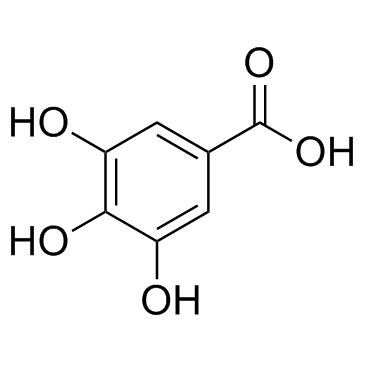 CAS#:149-91-7
CAS#:149-91-7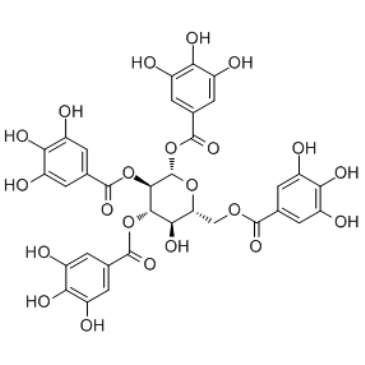 CAS#:79886-50-3
CAS#:79886-50-3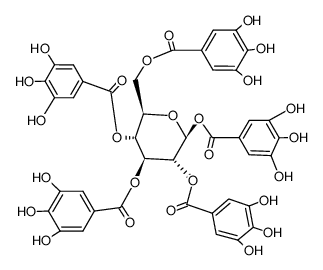 CAS#:70470-10-9
CAS#:70470-10-9![Benzoic acid,3,4-dihydroxy-5-[(3,4,5-trihydroxybenzoyl)oxy]- Structure](https://image.chemsrc.com/caspic/343/536-08-3.png) CAS#:536-08-3
CAS#:536-08-3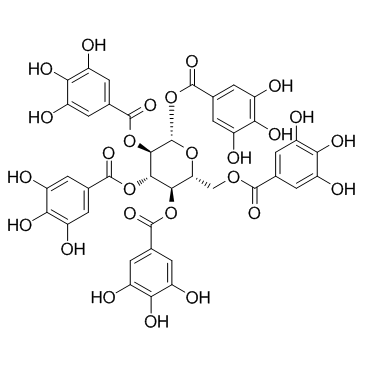 CAS#:14937-32-7
CAS#:14937-32-7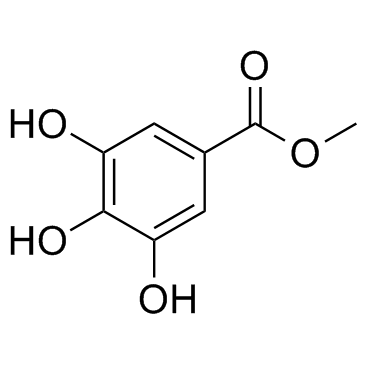 CAS#:99-24-1
CAS#:99-24-1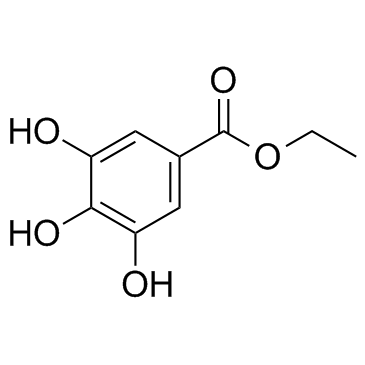 CAS#:831-61-8
CAS#:831-61-8 CAS#:79786-01-9
CAS#:79786-01-9 CAS#:100227-56-3
CAS#:100227-56-3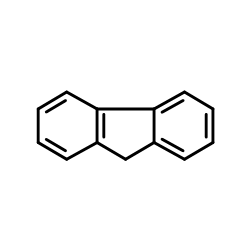 CAS#:86-73-7
CAS#:86-73-7 CAS#:4274-29-7
CAS#:4274-29-7
